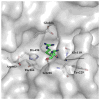Structure Determination of Mycobacterium tuberculosis Serine Protease Hip1 (Rv2224c)
- PMID: 28346784
- PMCID: PMC6033327
- DOI: 10.1021/acs.biochem.6b01066
Structure Determination of Mycobacterium tuberculosis Serine Protease Hip1 (Rv2224c)
Abstract
The Mycobacterium tuberculosis (Mtb) serine protease Hip1 (hydrolase important for pathogenesis; Rv2224c) promotes tuberculosis (TB) pathogenesis by impairing host immune responses through proteolysis of a protein substrate, Mtb GroEL2. The cell surface localization of Hip1 and its immunomodulatory functions make Hip1 a good drug target for new adjunctive immune therapies for TB. Here, we report the crystal structure of Hip1 to a resolution of 2.6 Å and the kinetic studies of the enzyme against model substrates and the protein GroEL2. The structure shows a two-domain protein, one of which contains the catalytic residues that are the signature of a serine protease. Surprisingly, a threonine is located within the active site close enough to hydrogen bond with the catalytic residues Asp463 and His490. Mutation of this residue, Thr466, to alanine established its importance for function. Our studies provide insights into the structure of a member of a novel family of proteases. Knowledge of the Hip1 structure will aid in designing inhibitors that could block Hip1 activity.
Conflict of interest statement
The authors declare no competing financial interest.
Figures








Similar articles
-
Mycobacterium tuberculosis Hip1 modulates macrophage responses through proteolysis of GroEL2.PLoS Pathog. 2014 May 15;10(5):e1004132. doi: 10.1371/journal.ppat.1004132. eCollection 2014 May. PLoS Pathog. 2014. PMID: 24830429 Free PMC article.
-
Design of Selective Substrates and Activity-Based Probes for Hydrolase Important for Pathogenesis 1 (HIP1) from Mycobacterium tuberculosis.ACS Infect Dis. 2016 Nov 11;2(11):807-815. doi: 10.1021/acsinfecdis.6b00092. Epub 2016 Jul 15. ACS Infect Dis. 2016. PMID: 27739665 Free PMC article.
-
2.1 Å crystal structure of the Mycobacterium tuberculosis serine hydrolase, Hip1, in its anhydro-form (Anhydrohip1).Biochem Biophys Res Commun. 2022 Nov 19;630:57-63. doi: 10.1016/j.bbrc.2022.09.021. Epub 2022 Sep 12. Biochem Biophys Res Commun. 2022. PMID: 36148729
-
HTRA proteases: regulated proteolysis in protein quality control.Nat Rev Mol Cell Biol. 2011 Mar;12(3):152-62. doi: 10.1038/nrm3065. Epub 2011 Feb 16. Nat Rev Mol Cell Biol. 2011. PMID: 21326199 Review.
-
Serine protease autotransporters of enterobacteriaceae (SPATEs): biogenesis and function.Toxins (Basel). 2010 Jun;2(6):1179-206. doi: 10.3390/toxins2061179. Epub 2010 May 28. Toxins (Basel). 2010. PMID: 22069633 Free PMC article. Review.
Cited by
-
Rv1288, a Two Domain, Cell Wall Anchored, Nutrient Stress Inducible Carboxyl-Esterase of Mycobacterium tuberculosis, Modulates Cell Wall Lipid.Front Cell Infect Microbiol. 2018 Dec 3;8:421. doi: 10.3389/fcimb.2018.00421. eCollection 2018. Front Cell Infect Microbiol. 2018. PMID: 30560095 Free PMC article.
-
The acid-base-nucleophile catalytic triad in ABH-fold enzymes is coordinated by a set of structural elements.PLoS One. 2020 Feb 21;15(2):e0229376. doi: 10.1371/journal.pone.0229376. eCollection 2020. PLoS One. 2020. PMID: 32084230 Free PMC article.
-
α/β Hydrolases: Toward Unraveling Entangled Classification.Proteins. 2025 Apr;93(4):855-870. doi: 10.1002/prot.26776. Epub 2024 Dec 2. Proteins. 2025. PMID: 39623291 Free PMC article.
-
N-Pyrazinoyl Substituted Amino Acids as Potential Antimycobacterial Agents-The Synthesis and Biological Evaluation of Enantiomers.Molecules. 2020 Mar 27;25(7):1518. doi: 10.3390/molecules25071518. Molecules. 2020. PMID: 32230728 Free PMC article.
-
Intramolecular C-C Bond Formation Links Anthraquinone and Enediyne Scaffolds in Tiancimycin Biosynthesis.J Am Chem Soc. 2022 Nov 9;144(44):20452-20462. doi: 10.1021/jacs.2c08957. Epub 2022 Oct 24. J Am Chem Soc. 2022. PMID: 36279548 Free PMC article.
References
-
- Global Tuberculosis Report 2015. World Health Organization (WHO); Geneva, Switzerland: 2015.
-
- Russell DG. Mycobacterium tuberculosis: here today, and here tomorrow. Nat Rev Mol Cell Biol. 2001;2:569–586. - PubMed
Publication types
MeSH terms
Substances
Grants and funding
LinkOut - more resources
Full Text Sources
Other Literature Sources
Molecular Biology Databases

